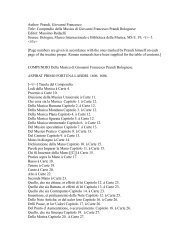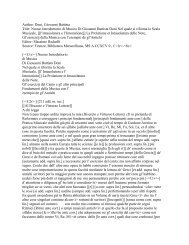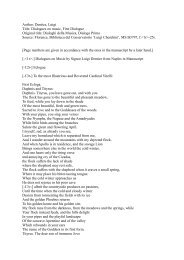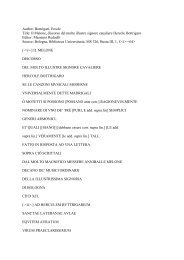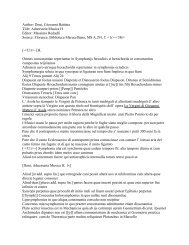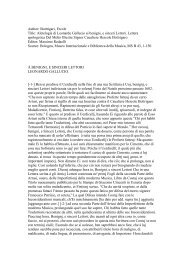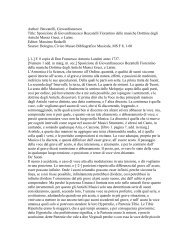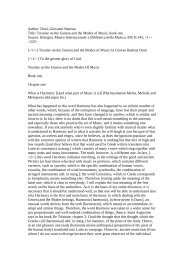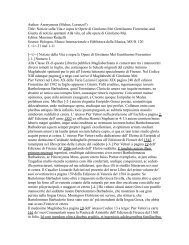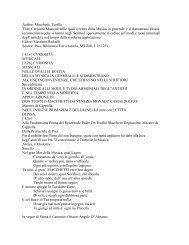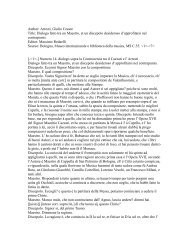Manuscripts of Italian Music Theory in Translation
Manuscripts of Italian Music Theory in Translation
Manuscripts of Italian Music Theory in Translation
You also want an ePaper? Increase the reach of your titles
YUMPU automatically turns print PDFs into web optimized ePapers that Google loves.
the bar [-f.28v-] and from it the bar [battuta] derives its name. I have read another Authornamed Diruta who wrote a treatise on the manner <strong>of</strong> play<strong>in</strong>g the Organ which he called IlTransilvano. He says on this matter, that the Bar is noth<strong>in</strong>g but a lift<strong>in</strong>g up and lower<strong>in</strong>gdown, but he does not state anyth<strong>in</strong>g more.Teacher: I reply to this that the beat is <strong>of</strong> two k<strong>in</strong>ds. One is called upbeat and the otherone is called downbeat. One has to consider that there are two motions: one is calledviolent motion and the other one natural motion. The natural motion cannot come beforethe violent one, <strong>in</strong> this <strong>in</strong>stance at least. I do not want to enter a dispute with thePhilosopher or the Mathematician about the slow, fast or perpetual motion, which is notrelevant to our purpose, nor do I want to enter such topic as does not befit me. However, Istate that the beg<strong>in</strong>n<strong>in</strong>g <strong>of</strong> the bar is born out <strong>of</strong> the violent motion, which is calledupbeat, and the end <strong>of</strong> the natural motion is the downbeat, nor one can exist without theother one. And if that Author wants to put forward such an argument, one does notbelieve him for this simple reason. However, I do not want to start a long dissertationabout this, s<strong>in</strong>ce I hope to deal with this <strong>in</strong> detail at another time. We will keep to ourstructure <strong>of</strong> the Syncopation, so that, when you want to weave it <strong>in</strong>to your Compositions,you do not have fail to observe its nature, with the warn<strong>in</strong>g that it can also be done withrests, which are put before the notes, as the above quoted Zarl<strong>in</strong>o demonstrates <strong>in</strong> a verylearned matter at Chapter 49 <strong>of</strong> the third part, as you will learn hear below, where heshows it only <strong>in</strong> the Tenor part, to which I have added the other three parts, namelySoprano, Alto and Bass.[-f.29r-] [Landi, Introduttione harmonica, 29r, 1]And, s<strong>in</strong>ce this can be shown <strong>in</strong> the whole <strong>of</strong> the Composition through the <strong>in</strong>tervention <strong>of</strong>rests, I come to provide you with this example.[Landi, Introduttione harmonica, 29r, 2]It is important that we remember well all the th<strong>in</strong>gs which we have seen and discussed upto now treat<strong>in</strong>g them with vivacity <strong>of</strong> m<strong>in</strong>d and realis<strong>in</strong>g them with every read<strong>in</strong>ess, sothat the Composition may be adorned with beautiful and attractive musical features.In how many ways one can resolve the dissonances.Chapter five.It would be really a grave mistake if we omitted to talk about the procedures to resolvethe dissonances, because, if everyth<strong>in</strong>g that [-f.29v-] has been said above is necessary tothis Art, this is even more necessary, because if a piece <strong>of</strong> <strong>Music</strong>, or a Composition iscompletely devoid <strong>of</strong> dissonances, it will be certa<strong>in</strong>ly <strong>of</strong> scarce or no value at all, becausethey are the ones which render the <strong>Music</strong> wonderful. One must be aware <strong>of</strong> the way <strong>in</strong>which they are <strong>in</strong>serted <strong>in</strong> the Composition, so that they produce a good comb<strong>in</strong>ation <strong>of</strong>sounds. The received op<strong>in</strong>ion is that the fourth is resolved with the third. I say that this isthe received op<strong>in</strong>ion, but it is necessary to know that the fourth can be resolved with the



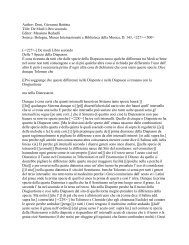
![Doni, Giovanni Battista Title: Trattato Dei Tuoni o [[Harmonie de]]](https://img.yumpu.com/45461005/1/190x245/doni-giovanni-battista-title-trattato-dei-tuoni-o-harmonie-de.jpg?quality=85)
